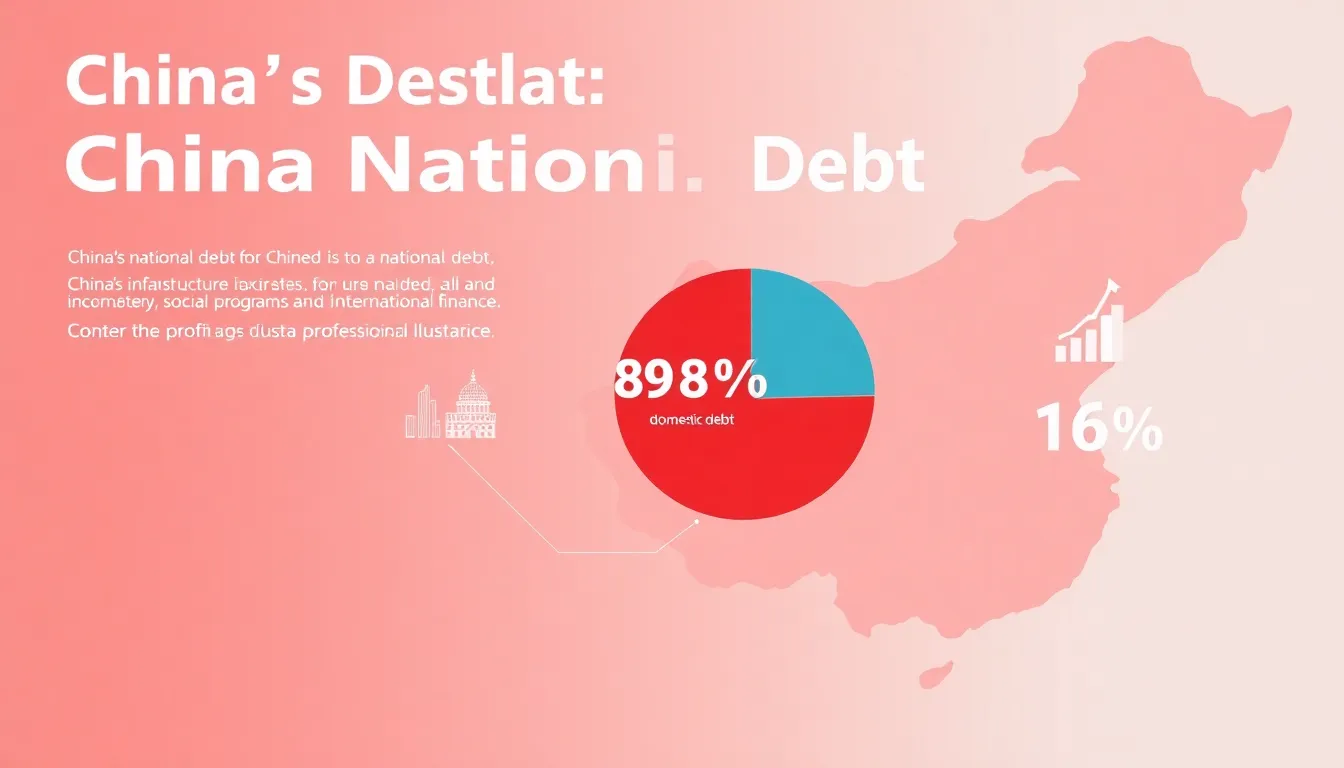China’s national debt might sound like a boring topic, but it’s as riveting as a high-stakes game of Monopoly—only with real money and way more players. As the world’s second-largest economy, China’s financial health is a hot topic that affects everything from global markets to your favorite takeout prices. So what’s the scoop on this massive debt?
Imagine a giant panda balancing on a tightrope made of cash. That’s kind of what China’s national debt looks like—impressive yet precarious. Understanding the intricacies of this debt isn’t just for economists in stuffy suits; it’s crucial for anyone who wants to grasp the larger picture of global finance. Buckle up as we dive into the numbers, the implications, and what it all means for the world stage.
Table of Contents
ToggleUnderstanding China’s National Debt
China’s national debt represents a crucial component of its economic structure. Grasping this concept reveals the complexities of its financial dealings.
Definition and Overview
China’s national debt refers to the total amount borrowed by the government and state-owned enterprises. This debt finances various projects, such as infrastructure and social programs. As of October 2023, estimates indicate that China’s national debt exceeds $15 trillion, making it the second-largest in the world. The ratio of debt to GDP currently stands around 60 percent, reflecting significant borrowing against national output. Understanding these figures aids in grasping how China’s debt influences both local and global economies.
Historical Context
China’s national debt has evolved significantly since economic reforms began in the late 20th century. In 2000, the debt was approximately $1.4 trillion. Rapid economic growth and increased infrastructure spending drove this figure to current levels. The global financial crisis in 2008 prompted further borrowing to stimulate the economy, leading to soaring debt levels. Additionally, various regional issues, such as trade tensions and COVID-19, influenced debt accumulation patterns. Analyzing this historical context sheds light on the driving forces behind China’s current financial status.
Components of China’s National Debt

China’s national debt consists of two primary components: domestic debt and foreign debt. Understanding these aspects reveals the structure of the nation’s financial obligations and its economic strategies.
Domestic Debt
Domestic debt refers to funds borrowed within China. The government typically issues bonds to finance infrastructure projects, social programs, and local government spending. As of October 2023, domestic debt represents roughly 84% of China’s total national debt. This figure highlights the reliance on internal borrowing to stimulate economic growth. Additionally, local governments often utilize financing vehicles to accumulate debt for regional development initiatives. These vehicles can create off-balance-sheet liabilities, complicating the overall debt landscape. Significant investments in urban development and infrastructure further drive up domestic debt levels.
Foreign Debt
Foreign debt comprises loans and debt instruments obtained from international creditors. This component of China’s national debt has grown steadily, now accounting for about 16% of the total debt. China engages in foreign borrowing to diversify financing sources and access foreign capital markets. International bonds and loans from foreign financial institutions facilitate funding for key projects, especially in developing nations under initiatives like the Belt and Road Initiative. This external borrowing aids China in expanding its influence globally while also exposing it to global financial market fluctuations. Overall, foreign debt plays a critical role in shaping China’s external financial relationships and investment strategies.
Causes of China’s National Debt Growth
China’s national debt growth stems from a combination of factors including economic policies and global economic influences.
Economic Policies
Economic policies play a significant role in expanding China’s national debt. The Chinese government has pursued aggressive fiscal strategies to boost infrastructure spending. This spending aims to stimulate economic growth, especially during downturns. The focus on ambitious projects led to substantial borrowing, primarily through government-issued bonds. Local government financing vehicles contribute significantly to debt, often creating off-balance-sheet liabilities. These initiatives, while fostering immediate economic development, increase overall debt levels and fiscal risk. Aimed at maintaining economic stability, these policies have unintended consequences, amplifying debt issues over time.
Global Economic Factors
Global economic factors heavily influence China’s national debt. Shifts in international trade dynamics, especially trade tensions and tariffs, create pressures on the Chinese economy. External funding becomes critical in times of uncertainty, leading to increased foreign borrowing. Economic slowdowns in major markets, including the U.S. and Europe, challenge China’s export-driven growth model. Additionally, fluctuating global commodity prices impact domestic stability and encourage borrowing for import stabilization. These external factors intertwine with domestic economic strategies, complicating China’s debt landscape and shaping future fiscal policies.
Implications of China’s National Debt
China’s national debt holds significant implications for both its domestic economy and the global financial landscape. Understanding these effects is critical for comprehending broader economic trends.
Economic Stability
Economic stability in China hinges on managing its national debt. A debt-to-GDP ratio of around 60 percent suggests a balanced approach, though excessive borrowing could lead to financial strain. Strong reliance on domestic debt, primarily funded through government bonds, underpins infrastructure projects and local initiatives. Local governments face risks due to off-balance-sheet liabilities from financing vehicles. This situation can hinder sustainable economic growth and create instability if not managed wisely. Investors and policymakers closely monitor these developments to assess potential risks.
Impact on Global Economy
China’s national debt directly impacts the global economy. As the world’s second-largest economy, any shift in its borrowing practices influences international markets. Foreign debt accounts for about 16 percent, connecting China to global financial systems and exposing it to external risks. Fluctuations in this debt can affect trade relations and foreign investments. Additionally, aggressive fiscal strategies can spark concerns regarding sustainability, impacting global confidence in financial markets. Both domestic policies and international relationships shape economic interactions, emphasizing the interconnectedness of the global economic landscape.
Managing China’s National Debt
China’s approach to managing national debt is multifaceted and strategic. The government utilizes various fiscal policies to control borrowing while promoting economic growth.
Government Strategies
Government initiatives focus on infrastructure investment as a means to stimulate the economy. Aggressive fiscal strategies have led to increased issuance of bonds to finance major projects. Policy frameworks encourage local governments to participate in funding through special bonds, which account for a significant portion of total borrowing. These policies aim to stimulate domestic consumption and generate economic activity. While these approaches foster growth, they also raise concerns about long-term fiscal sustainability. Monitoring debt levels and adjusting strategies remain crucial to prevent excessive strain on the economy.
Role of International Organizations
International organizations play a pivotal role in influencing China’s debt management practices. Entities like the International Monetary Fund (IMF) and World Bank offer guidance on fiscal policies and economic stability. They analyze China’s economic indicators and provide recommendations to mitigate risks associated with high debt levels. Engagement with these organizations allows China to align its financial strategies with global standards. Collaboration can improve transparency and foster investor confidence. Furthermore, international assessments often shape China’s borrowing decisions and strategies, reflecting its integration into the global economy.
China’s national debt is a complex and evolving issue that plays a critical role in its economic future. As the nation navigates its substantial borrowing practices and the implications for both domestic and global markets, the balance between growth and fiscal responsibility becomes increasingly vital.
The strategies employed by the Chinese government to manage this debt reflect a commitment to infrastructure and economic development. However, the risks associated with off-balance-sheet liabilities and reliance on domestic borrowing cannot be overlooked.
Investors and policymakers must remain vigilant as they monitor these dynamics, understanding that any shifts in China’s financial strategies will resonate far beyond its borders. The interconnected nature of today’s global economy means that China’s financial decisions will continue to shape international economic trends for years to come.


